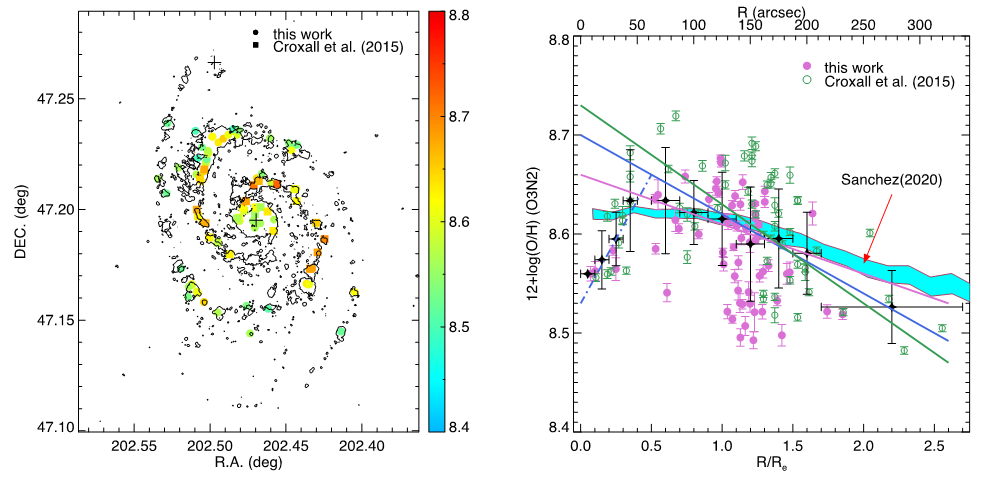Nearby galaxies are an ideal astrophysical laboratory for studying the galaxy formation and evolution, both observationally and theoretically. Star formation rate (SFR) is crucial for understanding the birth and evolution of the galaxies as it provides information on the amount of gas in galaxies and the efficiency in the formation of stars inside them, which depends strongly on the conditions of the interstellar medium in which they are formed. Metallicity is a key to understand the galaxy evolution as an independent tracer of the past star-formation activity. The two-dimensional distributions of metallicity and SFR can provide key observational constraints for studying galaxy evolution.
M51 (NGC 5194, also known as the Whirlpool nebula, α=13h29m52.71S, δ=+47°11′42.62 ) is a grand-design face-on spiral galaxy with the Hubble type of Sbc. Since M51 and its peculiar companion galaxy NGC 5195 are a close interacting galaxy pair, substantial H II regions have been formed in its spiral arms. The H II regions in M51 were observed using the 2.16 m telescope of the National Astronomical Observatories of the Chinese Academy of Sciences and the 6.5 m Multiple Mirror Telescope with spatial resolution of less than ~100 pc. We obtain a total of 113 spectra across the galaxy and combine the literature data of Croxall et al.(2015) to derive a series of physical properties, including the gas-phase extinction, stellar population age, SFR surface density, and oxygen abundance. Figure 1 shows the two-dimensional distribution and the radial profile of the oxygen abundance. We found that there is a positive metallicity slope in the inner region, which include the bulge and surrounding star-forming ring. This metallicity drop might be caused by the freezing of the chemical enrichment due to the star-forming quenching in the bulge-dominated inner region. There is a negative metallicity gradient of ?0.08 dex Re-1 in the disk region, which is also commonly found in many spiral galaxies. It is supported by the “inside-out” scenario of galaxy formation. The paper has been published in PASP (Wei et al. 2020, PASP, 132, 094101).
) is a grand-design face-on spiral galaxy with the Hubble type of Sbc. Since M51 and its peculiar companion galaxy NGC 5195 are a close interacting galaxy pair, substantial H II regions have been formed in its spiral arms. The H II regions in M51 were observed using the 2.16 m telescope of the National Astronomical Observatories of the Chinese Academy of Sciences and the 6.5 m Multiple Mirror Telescope with spatial resolution of less than ~100 pc. We obtain a total of 113 spectra across the galaxy and combine the literature data of Croxall et al.(2015) to derive a series of physical properties, including the gas-phase extinction, stellar population age, SFR surface density, and oxygen abundance. Figure 1 shows the two-dimensional distribution and the radial profile of the oxygen abundance. We found that there is a positive metallicity slope in the inner region, which include the bulge and surrounding star-forming ring. This metallicity drop might be caused by the freezing of the chemical enrichment due to the star-forming quenching in the bulge-dominated inner region. There is a negative metallicity gradient of ?0.08 dex Re-1 in the disk region, which is also commonly found in many spiral galaxies. It is supported by the “inside-out” scenario of galaxy formation. The paper has been published in PASP (Wei et al. 2020, PASP, 132, 094101).

Fig.1 The two-dimensional distribution and the radial profile of the oxygen abundance of H II region in M51. Left: The contours display the isophotal shapes of the Hα emission. The centers of M51 and NGC 5195 are marked with pluses. Right: The filled circles and open circles are the data from this work and Croxall et al. (2015), respectively. The black stars with error bars are the mean values, while the horizontal bars show the range of each bin. The blue dashed line shows the positive slop at R/Re<0.4, while the blue solid line shows the negative gradient at R/Re>0.4. The violescent and green lines display the gradients for the data in our work and the data of Croxall et al. (2015) at R/Re>0.4, respectively. The radial distribution of oxygen abundance for Sbc-type galaxies with 1010.5 M☉ < M*<1011 M☉ from Sa?nchez (2020) is shifted upward by 0.035 dex to match our data and overplotted in cyan.
Contact: WEI Peng
Xinjiang Astronomical Observatory, Chinese Academy of Sciences
Email: weipeng@xao.ac.cn